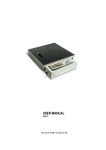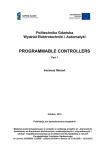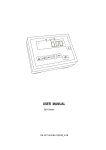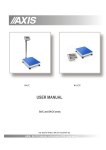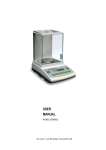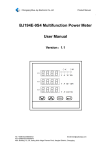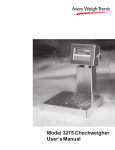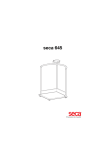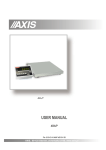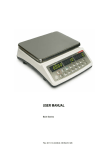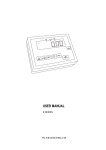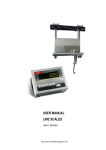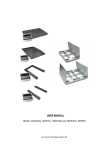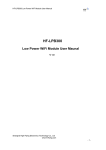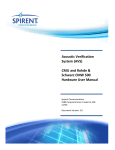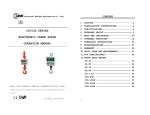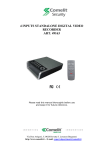Download BALANCE INSTRUCTION MANUAL
Transcript
BALANCE INSTRUCTION MANUAL SERIES 4B/PA File: 2012-04 R-4BPA-047 B-50_4 GB 2 INSTRUCTION MANUAL _____________________________________________________________________________________________________________________ Table of contents: 1. General description ............................................................................................................................................. 3 2. Completation ....................................................................................................................................................... 4 3. Technical data ..................................................................................................................................................... 4 4. Safety principles .................................................................................................................................................. 5 5. Principles of used balance treatment................................................................................................................... 5 6. Balance keys and indicators ................................................................................................................................ 6 7. Balance preparation to work ................................................................................................................................ 7 8. Balance start........................................................................................................................................................ 8 9. Operation principles ............................................................................................................................................. 9 10. Balance test .................................................................................................................................................. 10 11. Balance adjustment ...................................................................................................................................... 10 12. Connection with computer, printer or label printer ........................................................................................ 10 13. Basic function ............................................................................................................................................... 14 13.1 Normal weighing ........................................................................................................................................... 14 13.2 Weighing with tare ........................................................................................................................................ 15 13.3 Increased readability ..................................................................................................................................... 15 14. Special functions describtion ........................................................................................................................ 16 14.1 Menu customization function (ACtIV and dEFAUL) ...................................................................................... 17 14.2 Autozeroing function (AutoZE) ..................................................................................................................... 18 14.3 Pieces counting (PCS) ................................................................................................................................. 19 14.4 Printer cooperation settings (PrInt) .............................................................................................................. 20 14.5 Serial port parameters setting (Port) ............................................................................................................ 21 14.6 Constant tare (tArE) ...................................................................................................................................... 22 14.7 Average calculation function (AVErAG) ....................................................................................................... 24 14.8 Recipe weighing function (RECIPE) ............................................................................................................ 25 14.9 Percentage weighing function (PErC) .......................................................................................................... 26 14.10 Anti-disturbance filter function (FILtEr) .................................................................................................... 27 14.11 Function for maximum value indication (UP)............................................................................................ 28 14.12 Force measuring function (nEWto) ......................................................................................................... 29 14.13 Function for weighing large animals (LOC) .............................................................................................. 30 14.14 Checkweighing function (thr).................................................................................................................... 31 14.15 Total weight function (totAL) .................................................................................................................... 34 14.16 Function for setting date and time (dAtE) ................................................................................................. 36 14.17 Function for selecting label number (LAbEL) ........................................................................................... 37 14.18 External calibration (CALIb) ..................................................................................................................... 38 14.19 Setting time of stabilization function (Stb) ................................................................................................ 39 14.20 Entering reference zero function (Zero) ................................................................................................... 40 14.21 Automatic switching off the scale function (AutoOF) ................................................................................ 41 14.22 Density determining function (dEnSIt) ...................................................................................................... 42 14.24 Statistical calculations function (StAt) ...................................................................................................... 44 15. Maintenance and small repairs ............................................................................................................................ 46 Declaration of Conformity............................................................................................................................................ 47 Appendix A .................................................................................................................................................................. 48 INSTRUCTION MANUAL 3 _____________________________________________________________________________________________________________________ 1. General description Pallet balances from 4B/PA series in basic version from lacquered steel, with SE01/A/18 meter, are designed for operation in light environmental conditions. Manual describes standard balance version. In case of special meter use, e.g. dosing meter, it is necessary to use documentation for meter as well. All balances are tested in respect of metrology. According to order, balances may be verified or calibrated. EC verification (conformity assessment) of balances is required for special applications, mentioned in Ministry of Labour and Social Policy decree from 11.12.2003 (trade, tariffs, pharmacy recipes, medical and pharmaceutical analysis, packing of goods). For other applications it is recommended to replace verification with calibration. Verified balances have the following verification features: - protection stamps, located on balance meter and converters connection box (installed under the bearing surface). - Office of Measures marks and green metrological mark, located on the rating plate. EC verification is valid for 25 months from 1st of December of year, when the EC verification took place, under condition of stamp integrity. Balances classification (PKWiU code) 29.24.23. Certificates: Certificate of type approval no. PL 04 020 Certificate DIN EN ISO 9001:2000 no. 78 100 6386 (AXIS management system) 4 INSTRUCTION MANUAL _____________________________________________________________________________________________________________________ 2. Completation Basic set includes: 1. Bearing surface and balance meter, connected permanently with cable 2. RS232C connector (only 4B/PAN balances) 3. Instruction manual 4. Warranty 3. Technical data Balance type Maximum load (Max) Reading graduation (d) Verification graduation (e) Minimum load (Min) Tare set range Precision class Operational temperature Weighing time Internal bearing surface dimensions (WxLxH) External bearing surface dimensions (WxLxH) Entrance dimensions Display cable length Power supply Balance weight Meter protection rating Sensors protection rating 4B300 PA(N) 300kg 0,1kg 0,1kg 2kg -300kg 4B600 PA(N) 600kg 0,2kg 0,2kg 4kg -600kg 4B1000 PA(N) 1000kg 0,5kg 0,5kg 10kg -1000kg 4B1500 4B2000 PA(N) PA(N) 1500kg 2000kg 0,5kg 1kg 0,5kg 1kg 10kg 20kg -1500kg -2000kg III -10÷40°C <4s 600x1135x78mm 4B3000 PA(N) 3000kg 1kg 1kg 20kg -3000kg 600x1135x80mm 840x1260x78mm 600mm 4m ~230V, 50Hz, 8VA 70kg 4B/PA - no IP 4B/PAN (stainless balances) - IP65 4B/PA - IP67 4B/PAN (stainless balances) - IP68 INSTRUCTION MANUAL 5 _____________________________________________________________________________________________________________________ 4. Safety principles It is necessary to become familiar with safety principles shown below, which are necessary to avoid electric shock and damage of balance or connected devices. • • • • • • • Repairs and necessary adjustments must be performed by qualified personnel only. To avoid fire hazard, use only typical supply cable, and supply voltage must be consistent with technical data. For the balance supply use the socket with protective contact. Do not use balance when the cover is removed. Do not use balance in explosive atmosphere. Do not use balance in locations with high humidity, when the cover does not have special protections (PAN types). In case of damage suspicion, switch the balance off and do not use it until it is tested in professional service company. 5. Principles of used balance treatment According to valid regulations regarding natural environment protection do not place used electronic devices in containers with common waste. • Used balance after operation period may be transferred to units authorized for collection of used electronic equipment, or to place of purchase. 6 INSTRUCTION MANUAL _____________________________________________________________________________________________________________________ 6. Balance keys and indicators wskaźnik masy brutto wskaźnik f. liczenia sztuk zwiększenie rozdzielczości key key key key key key key indicator indicator indicator indicator indicator wskaźnik wskaźnik wskaźnik stabilizacji masy netto zera brutto / netto I/ →T← B/G →0← MENU HR →0← NET menu wydruk zerowanie funkcji dane wynik ważenia metrologiczne tarowanie włącznik / wyłącznik - ON/OFF switch (standby), - tare setting (entering of mass subtracted from weighed mass), - gross weight indication, - zeroing, - special functions menu, - result print, - weight indication resolution increasing, - zero indicator (for unloaded balance), - signals weighing result stabilization, - net weight (after →T← key use), - gross weight (after B/G key use), - pieces counting function indicator (indications in pieces) Additionally in LCD display version: indicator MODE - special function activation menu, indicator bar - balance load indicator (0-100%), indicator WYŁ - balance switched off with key (standby), indicator B/G - gross weight (after B/G key use), indicator pcs - indications in pieces INSTRUCTION MANUAL 7 _____________________________________________________________________________________________________________________ 7. Balance preparation to work 1. Unpack balance, removing protective foils. 2. Place balance on flat, horizontal foundation, in place not subjected to mechanical vibrations and strong air movements. 3. Air bubble in level should be located in the middle position. Good Bad 4. Attach meter to the wall, desktop or tripod (option), choosing one of three methods. 5. Connect the supply cable plug to socket with protective contact, when balance is unloaded. 8 INSTRUCTION MANUAL _____________________________________________________________________________________________________________________ 8. Balance start Connecting of supply plug to socket of ~230V/50Hz installation with unloaded balance will cause the following sequence of actions: Display test Tests of basic electronic subassemblies, ended with messages: C1, C-2, ... C-6. Displaying of software version. Ready for operation. INSTRUCTION MANUAL 9 _____________________________________________________________________________________________________________________ 9. Operation principles 1. Before each measurement the balance should be properly zeroed, which is signalled by “→0←” indicator. If the zero indication is not shown when the balance is unloaded, or "----" is displayed, press the "→0←" key. 2. The balance enables tare setting in the whole measuring range. It is performed by pressing "→T←" key. 3. Weighed mass should be placed in the platform centre. Do not drop weighed objects on the platform. Do not overload the balance over 20% of maximum load. 4. The weighing result should be read during the " " indicator lighting, which indicates the result stabilization. 5. When there is no weighing, but the balance should be ready for operation, it may be switched off by I/ key. It causes the balance reading system deactivation end entering the standby mode. Balance turning on is performed by pressing " I/ " key. 6. Protect the balance from dust, aggressive dusts and liquids. For cleaning purposes use water and dry it. 10 INSTRUCTION MANUAL _____________________________________________________________________________________________________________________ 10. Balance test During balance operation, in order to confirm its efficiency, it is recommended to check the weighing precision by putting and object of exactly known weight before and after series of measurements. For testing of verified balances use weight standard, having valid standardization certificates. In case of allowable measurement error exceeding contact authorized service company to perform balance adjustment. 11. Balance adjustment Balance adjustment must be performed by authorized service company only, as it is connected with necessity of seals breaching, required for warranty purposes. 12. Connection with computer, printer or label printer 1 RxD (receiver) TxD (transmitter) 2 6 7 3 8 4 5 GND 9 Case The scale is equipped with RS232C or RS485 (optional), which can be used to connect external devices such as a computer or a printer. Detailed way of communication data is defined by one of protocol: - LonG – protocol to printer and computer - ELtron – protocol to label printer When cooperating with a printer data is send automatically after result stabilisation, but next transmission is possible after removing previously weighted sample. RS485 (option) When protocol Long is chosen scale sends result of weighting under the influence of initializing signal from computer, or after 1 6 pressing a key. A 2 Input 7 When automatic transmission mode is B 3 chosen (function PrInt), a printer data is send 8 A 4 Output automatically after result stabilisation, but 9 B 5 next transmission is possible after removing previously weighted sample. The scale sends Case following information: successive number of weighing, date and time (if clock module is installed )and weighing result. During transmission communicate Print is displayed. It is also possible by scale to display text message sent from computer confirming received information. } } INSTRUCTION MANUAL 11 _____________________________________________________________________________________________________________________ Scale with Eltron protocol sending record of data after pressed key. The scale sends following information: number of label, date and time (if clock module is installed ) and weighing result. During transmission communicate Label is displayed. In special features scale can be equipped in second RS232 interface for additional functions, ex. continuous transmitting of indications to second display. Computer must have a special program for cooperation with data from a scale. Programs offer is available on www.axis.pl/en internet site. Detailed protocol description LonG protocol Communication parameters: 8 bits, 1 stop bit, no parity, baud rate 4800bps, Readout of scale indication ( corresponds to pressing key Computer→Scale: S I CR LF (53h 49h 0Dh 0Ah), Scale→Computer: scale response according to description below (16 bytes): Byte Byte Byte Byte Byte Byte Byte Byte Byte Byte Byte 1 2 3÷4 5÷9 10 11 12 13 14 15 16 - sign „-” or space space digit or space digit, decimal point or space digit space k, l, c, p or space g, b, t, c or % space CR LF Attention: Network number different than zero (F..-rS / nr function) changes scale working mode: communication with a computer is possible after logging the scale in with 02h scale number command. To log the scale out use 03h command. For example: Using a program to test RS232 interface ( program is available on www.axis.pl in computer programs section) for scale number 1 please write: $0201 to log in, then SI, and write: $03 to close communication. 12 INSTRUCTION MANUAL _____________________________________________________________________________________________________________________ Asking for scale presence in system (testing scale connection with computer): Computer→Scale: S J CR LF (53h 4Ah 0Dh 0Ah), Scale→Computer: M J CR LF (4Dh 4Ah 0Dh 0Ah), Displaying a sign on scale display (text message from computer): Computer→Scale: S N n n X X X X X X CR LF (53h 4Eh 0Dh 0Ah), nn-displaying time in seconds; XXXXXX- signs to display Scale→Computer: M N CR LF (4Dh 4Eh 0Dh 0Ah), Scale tarring (calling →T← key press) : Computer→Scale: S T CR LF (53h 54h 0Dh 0Ah), Scale→Computer: without response, Scale zeroing (calling →0← key press): Computer→ Scale: S Z CR LF (53h 5Ah 0Dh 0Ah), Scale →Computer: without response, Scale turning on / off (calling I/ key press): Computer→ Scale: S S CR LF (53h 53h 0Dh 0Ah), Scale →Computer: without response, Entering to special function menu (calling MENU key press): Computer→ Scale: S F CR LF (53h 46h 0Dh 0Ah), Scale →Computer: without response, Setting low threshold value (option): Computer→ Scale: S L D1...DN CR LF (53h 4Ch D1...DN 0Dh 0Ah) D1...DN – threshold value, maximum 8 characters („-” – negative value, digits, dot – decimal separator), number of digits after dot should be the same as on scale display, Scale →Computer: without response, Example: ⋅ in order to set low threshold 1000g in scale B1.5 (d=0.5g) the following order should be sent: S L 1 0 0 0 . 0 CR LF (53h 4Ch 31h 30h 30h 30h 2Eh 30h 0Dh 0Ah), ⋅ in order to set low threshold 100kg in scale B150 (d=50g) the following order should be sent: S L 1 0 0 . 0 0 CR LF (53h 4Ch 31h 30h 30h 2Eh 30h 30h 0Dh 0Ah),), Setting high threshold value (option): Computer→ Scale: S H D1...DN CR LF (53h 48h D1...DN 0Dh 0Ah), D1...DN – threshold value (see ) Scale →Computer: without response. INSTRUCTION MANUAL 13 _____________________________________________________________________________________________________________________ Connecting cable WK-1 (scale – computer / 9-pin interface): Protocol ELTRON description Communication parameters: 8bits, 1stop, no parity, 9600bps, After use key scale send: Scale→Label printer : EPL-2 language instruction to initialize print of label: US FR"0001" ? hh:mm yyyy.mm.dd mass + unit P1 - control instruction number of labels starting instruction 5 signs: hours:minutes 10 signs: year.month.day 10 signs: scale indicate + mass unit ending instruction Attention: 1. It is possible to place a constant signs (company name, product name). 2. The default number of label’s is 0001 (label number 1).Different numbers of label are possible by using a LAbEL function. 3. Label formula must be saved in printer – label forma must be designed in computer (by Zebra Designer program) and saved in printer. 4. Parameters and protocol of transmission must be compatible with printer label 14 INSTRUCTION MANUAL _____________________________________________________________________________________________________________________ 13. Basic function To make clear how to manage with each function, in further part of instruction descriptions are replaced with pictures. - put a load on the pan - remove the load from the pan 2.30 - T press the key when indication is displayed - forced change - automatic change 13.1 Normal weighing 0.00 2.30 0 Press →0← key (→T← key in nonlegalized scales), which zeros the scale, operates only when the pan is empty . Weighing result should be read when the indicator " " lights. INSTRUCTION MANUAL 15 _____________________________________________________________________________________________________________________ 13.2 Weighing with tare 2.30 NET 0.00 NET 40.01 42.31 T The scale is equipped with tare equal to its range. Joint value tare and mass net can not cross a maximum of scale. To display gross weight press B/G key. Note: Press B/G key to return to net weight indication. 13.3 Increased readability 2.30 2.29 2.30 Press HR key to display the weighing result (for 5s.) with the highest readability possible. This function is especially helpful in scales with legal verification with d=e. The weighing result with increased readability can be used for informational purposes only and cannot be printed or sent to a computer with key. 16 INSTRUCTION MANUAL _____________________________________________________________________________________________________________________ 14. Special functions describtion List of available functions: menu customization function (ACtIV), removal of all function from menu (dEFAUL). autozeroing function (AutoZE), pieces counting function (PCS), function for setting serial port working (PrInt) function for setting serial port (Port) entering tare function (tArE) recipe weighing function (rECIPE), weighing large animals function (LOC) force measuring function (nEWto) maximum value indication function (UP) anti-disturbance filter function (FILtEr) average calculating function (AVErA) percentage weighing function (PErC), extended calibration function (CALIb) setting time of stabilisation function (Stb) selecting label number function (LabEL) automatic switching off scale function (AutoOF) entering reference zero (Zero) determining solids and liquids density function (dEnSIt) calculator for good packaging control (tP) - option* statistical calculations (StAt)- option* paperweight calculation function (PAP) - option* function with additional equipment require: options with the clock: - setting current date and time function (dAtE) - total weight function (totAL) options with the transoptors connectors: - checkweighing function (thr) * Functions offered with special version of scale software (with limited possibility of using other special functions). User create own menu by choosing function in ACtIV function (described in chapter 14.1). INSTRUCTION MANUAL 17 _____________________________________________________________________________________________________________________ 14.1 Menu customization function (ACtIV and dEFAUL) 0.00 ACtIV . PCS Port T Operation sequence shown in the pictures on the left causes adding function for setting serial interface RS232C parameters (Port) to function menu. . . T Port -0 Port -1 Among available user functions it is possible to select these, which should be displayed after pressing MENU key. It allows avoiding displaying whole list of available functions, which makes operation time longer. After switching on ACTIV function a dot is displayed on the right side (to distinguish from regular menu). Chosen functions are displayed with a dot on the left side. In every moment, it is possible to restore primary (manufacture) settings choosing dEFAULt special function. T In order to remove function from menu in the last operation in place of selecting Port -1 choose Port -0. 18 INSTRUCTION MANUAL _____________________________________________________________________________________________________________________ 14.2 Autozeroing function (AutoZE) 0.01 AutoZE T Aut-0 Aut-1 0.00 T When F..-Aut function is activated, the scale automatically ensures stable zero indication if the pan is empty or if zero indication was acquired by pressing →T← key. To leave the function press MENU key, then with →T← key chose AutoZE and Aut-0. Note: Autozeroing function is activated automatically for 10 min. after switching-on. INSTRUCTION MANUAL 19 _____________________________________________________________________________________________________________________ 14.3 Pieces counting (PCS) 0.00 T 5 23.40 PCS T PCS -0 PCS-1 T PCS - -- 5 0 12 12 This function enables to count identical pieces, e.g. turnbuckles or buttons. A measurement is performed in two phases: - first phase - single piece weight calculation on the basis of defined pieces amount (5, 10, 20, 50, 100, 200 or 500 pieces), - second phase – pieces counting. It is advised that single piece weight is not less than one reading unit and sample weight used in first phase is bigger than 100 reading units. To leave function press MENU key and then with →Τ← key chose PCS and PCS-0. T Note: 1. Err-3 communicate signalises that a sample was not put on the pan. The same communicate appears if single piece weight is less than one reading unit (it is possible to count pieces but measuring error is bigger). 2. To chose previously used pieces amount select " _ _ " in first phase (in case no value was chosen, error communicate appears 3. During pieces counting →T← key function does not change. 4.In scales equipped with LCD display, weighing unit is visible and "" sign is replaced with "pcs ". 20 INSTRUCTION MANUAL _____________________________________________________________________________________________________________________ 14.4 Printer cooperation settings (PrInt) 0.00 PrInt T PrIn-0 PrIn-1 0.00 1.05 PrInt T Activate the function for automatic serial port working mode (cooperation with a printer. After activation the scale prints a header. Weighing result with a successive measurement number is printed automatically after result stabilisation (without using key). To select computer cooperation mode ( key activated and weighing results without successive numbers) press MENU key, then with →T← key chose PrIn-0 and PrIn-1. INSTRUCTION MANUAL 21 _____________________________________________________________________________________________________________________ 14.5 Serial port parameters setting (Port) 0.00 Port T - Port-0 Port-1 - T - baud T - -4800 -9600 T bIt T PArItY T Odd T Send T nr T out T The function enables to set the following transmission parameters (standard parameters underlined: transmission protocol (Prot): LonG - printer, ELtron – label printer, transmission speed (bAud: 1200, 4800, 9600, ...), the number of bits in a byte (bit: 7, 8), parity control (PArItY: 0, 1; Odd: 0, 1), network number when working in multistand computer system (when working as a single scale the value should be “0”, continuous transmission – without key, approx. 10 results per using second (SEnd: 0, 1). Protocol Eltron automaticly activated function LAbEL. To set desired transmission parameters activate Port function, choose appropriate parameter and press →T← key to accept needed parameter value. The example at the left presents how to set transmission speed value to 9600bps. To leave the function choose out option. 22 INSTRUCTION MANUAL _____________________________________________________________________________________________________________________ 14.6 Constant tare (tArE) This function enables to measure gross weight of a sample placed in a container of a known weigh value (stored in the memory) and to display calculated net weight of the sample. Tare value is recalled from the memory with →0← key when the pan is empty. Tare value may be entered using the keypad or by sampling container weight from the pan. Operation sequence: The following options are possible: - tAr-0 – leave the function, - tAr-1 – activate the function with the previous tare value, - tAr-2 – sample tare value from the pan, - tAr-3 – enter tare value with keys: →0←, , →T← and MENU - tAr-4 – printout a setting value of tare 1.70 tArE T tAr -3 T - ... Options tAr-1 enables to activate the function with previous tare value after leaving the function with tAr-0 option. 1 1. 1.0 1.7 NET 0.00 If the function is active, NET indicator is displayed. T ... Note: Tare value is stored in memory also after unplugging the scale from the mains. INSTRUCTION MANUAL 23 _____________________________________________________________________________________________________________________ Weighing with constant tare: -1.70 0 When tAr function is activated, press →0← key to zero the indication and to recall tare value from the memory. Tare value is displayed with ”-” sign. NET 10.00 . B/G B/G key enables for instant switching between net and gross weight. 13.70 Note: When the pan is empty →T← key does not operate – to tare the scale use →0← key. 24 INSTRUCTION MANUAL _____________________________________________________________________________________________________________________ 14.7 Average calculation function (AVErAG) The function allows for calculating average value of performed measurement series. During series of measurements successive results are registered automatically when scale indication is stabilised. 0.00 AUErAG AUEr- 1 1.00 0.00 2.00 0.00 n 2 _ _ 1.50 Press MENU key and select AUErAG MENU pressing →T← key. The following will be shown successively on display: - AUEr-0 – leaving function, T - AUEr-1 – measurement with average calculation.. Select AUEr-1. It will allow weighing T with simultaneous storing results into summing register for average calculation Measurement registration is performed automatically in the moment when scale indication becomes stable. Short time displaying of „ - - ” denotes that load can be taken off and new one can be put on. Results above scale Min are registered only. Number of measurements is limited to 9999. In order to read average value key should be used. - first pressing causes displaying number of measurements (n). - second displaying causes displaying average value (=). - third pressing allows continuing average calculation. If a printer is connected to scale the following report will be printed : Date: ... 0.00 Time. ... MEASUREMENS No = ... AVERAGE VALUE = ... In order to finish calculation press MENU key, and then select AUEr i AUEr-0. INSTRUCTION MANUAL 25 _____________________________________________________________________________________________________________________ 14.8 Recipe weighing function (RECIPE) 0.00 rECIPE MENU T rECI- 0 A rECI- 1 _ _ _ B 0.11 T _ _ _ 0.00 _ _ _ 0.13 rECIPE A+ B+ C T _ _ _ 0.00 _ _ _ 0.12 C T rECI- 0 _ _ 0.36 MENU This function allows for separate weighing of several ingredients in one container with a possibility of control total weight of all weighed components. The function has the following options: - rECI-0 – leave the function with possibility of reading to read total weight, - rECI -1 – start recipe weighing - rECI -2 – continue previous recipe. When preparing a recipe successive ingredients (A, B, C, etc.) are weighed each time starting from zero indication. In order to allow this after weighing of each ingredient tare the scale. After weighing of several ingredients reading total weight is possible (despite scale taring). In order to do that press MENU key, select rECIPE function once more and use rECI -0 option. _ Sign „ _ ” signals total weight indication. Recipe is finished when →T← key _ is pressed. When „ _ ” sign is displayed recipe continuing is possible. rECI -2 option is used for that. T T Note: Sign „≡” on the left side of display informs about rECIPE function activity. 26 INSTRUCTION MANUAL _____________________________________________________________________________________________________________________ 14.9 Percentage weighing function (PErC) 0.00 100% 1.70 PErC T PErC-0 PErC-1 _ _ 100.00 5% _ _ 95.00 T This function allows displaying weighing result in percents. A measurement is performed in two phases: - first phase – weighing a reference sample (100%), - second phase – measuring specific sample as a percentage of the reference sample. Weighing result is displayed in different format, depending on the weight value of reference sample. For weight values of reference sample 0÷3,5% of weighing range result is displayed in format 100, for range 3,5÷35% - in format 100.0, and above 35% - in format 100.00. _ „%” sign is replaced with „ _ ” indicator. The function has the following options: - PErC-0 – disable the function, - PErC-1– set current scale indication as 100% and activate percentage weighing, - PErC-2 – continue percentage weighing after exiting to normal weighing. Note: During percentage weighing →T← key has its normal function. INSTRUCTION MANUAL 27 _____________________________________________________________________________________________________________________ 14.10 Anti-disturbance filter function (FILtEr) 0.00 FILtEr T Press MENU key and select FILtEr pressing →T← key. The following options will be shown successively on display: - FIL-0 – work without - FIL-1 - filter I (weak) - FIL-2 - filter II (medium) - FIL-3 - filter III (sharp) - FIL-4 - filter IV (very sharp) Select on of four filters. This will cause starting weighing with selected filter. FIL- 0 FIL- 1 FIL- 2 FIL- 4 0.00 This function allows using digital filter with selected intensivity during weighing. Filter reduces the influence of mechanical vibrations (air blasts, base vibrations) on measurement result. T In order to go back to normal weighing use MENU key once more and choose FILtEr and FIL-0. 28 INSTRUCTION MANUAL _____________________________________________________________________________________________________________________ 14.11 Function for maximum value indication (UP) This function allows holding on display maximum value shown by the scale in a while. Before measurement scale should be tared. 0.00 UP T After using MENU key and selecting UP function the highest mass result will be hold on display. UP- 0 Pressing →T← key will cause result zeroing. UP- 1 1.00 1g 1g 10.00 10.00 T Note: Autozeroing function and the stabilisation indicator are deactivated when UP function is running. Weighing result is continuously averaged from 5 measurements. INSTRUCTION MANUAL 29 _____________________________________________________________________________________________________________________ 14.12 Force measuring function (nEWto) Function activation causes displaying result in force units (N). 0.0 Press MENU key. nEWto T Note: 1N≈0,1019kg nEW -0 nEW -1 0.000 Using →T← key choose function, and then NEW-1. T NEWto 30 INSTRUCTION MANUAL _____________________________________________________________________________________________________________________ 14.13 Function for weighing large animals (LOC) The function allows weighing animal moving on the scale. 0.00 LOC MENU T LOC -0 LOC -1 T Press MENU key. When LOC function is displayed press →T← key. The following options appear on display successively: - LOC-0 – leave the function, - LOC-1 – automatic weighing after loading the scale, - LOC-2 – the measurement initiated manually by pressing key. When LOC-1F..-1 is displayed press →T← key. Tare the scale using →T← key if necessary and place the animal on the pan. 0.25 PrInt 0.25 Wait until the weighing result is averaged – scale display will be blinking. Then scale will show stable averaged result and will send it through serial port. Final result is displayed on the display and send via serial port to computer or printer. The result remains on display for about 30 second. Important notes: 1. The loads less than Min are not averaged. 2. In the case when placing the animal takes more than 5s, it is advised to use LOC-2 option (measurement initiated manually). It will allow performing measurement in right moment pressing key. 31 INSTRUCTION MANUAL _____________________________________________________________________________________________________________________ 14.14 Checkweighing function (thr) This function allows comparing weighing result with two programmed reference values: lower and upper threshold. Comparison result is signalled with indicators (MIN, OK, MAX) and sound signal generated when threshold values are exceeded. If comparison result is: - smaller than lower threshold – the scale signals MIN (yellow colour), - between threshold values - the scale signals OK (green colour, with the short sound signal), - greater than upper threshold - the scale signals MAX (red colour, long sound signal). The checkweighing results can be use to control: - optical indicator (Indication mode), - batching devices (Batching mode). - Standard scale is set for cooperation with optical indicator. On outputs P1-P3 (Relays socket) short-circuit states appear as result of comparison scale indication with threshold values. On the chart below output states are shown during increasing load on the scale for both working modes: Indication mode: P1 Batching mode: P1 zero treshold thr I thr I P2 P2 thr I thr II P3 thr II P3 thr II zero treshold In Batching mode on P1 (thr I) and P2 (thr II) outputs short-circuit impulses appears for time of 0,5s. On P3 (zero) output short-circuit state appears when indication does not exceed threshold value signalling zero load. 32 INSTRUCTION MANUAL _____________________________________________________________________________________________________________________ Relays connection diagram: Scale Relay Imax < 25mA Relays output is the open collector transoptor output with load capacity 25mA / 24V. Transmitter inputs must be protected with diodes, e.g. 1N4148. It is advised to use MS3K/P electronic board (sold separately), consisting of RM96P transmitters, with DC24V input voltage and AC250V, 3A output. Important notes: 1. After switching the scale on, both thresholds are set to maximum values. 2. When setting upper threshold value, pay attention that its value is not below lower threshold value. 3. Setting lower and upper threshold value is possible after sending appropriate orders from computer, what is described in scale user manual. INSTRUCTION MANUAL 33 _____________________________________________________________________________________________________________________ Operation sequence: 0.00 thr thr -0 thr -1 SEt-1 5 550 SEt-2 100 SEt-0 62.00 Press MENU key and choose thr pressing →T← key. The following options are displayed successively: - thr-0 – deactivate the function, T - thr-1 – activate the function, - thr-P – check last threshold values (press key several times), - thr-t – choose Relays socket mode: 0 – exit to weighing 1 – Batching mode T 2 – Indication mode. Choose thr-1option using →T← key. The following options for entering thresholds are displayed: T - SEt-0 - go to weighing with signalling threshold excess, - SEt-1 - set lower threshold value, 0 - SEt-2 - set upper threshold value, -SEt-3 - set zero signalisation threshold. Using →T← key select SEt-1 option. Set lower threshold value using the T following keys: →0← - digit increase, - decimal point, 0 →T← - move to next digit, MENU - finish. MENU Then select SEt-2 option and enter upper threshold value. T Choosing Set-0 option will cause starting work with signalisation of exceeding thresholds and zero. MENU To change Relays socket mode use thr-t option. Default option is Indication. T To leave the function, press MENU key and then choose thr and thr-0 options. 34 INSTRUCTION MANUAL _____________________________________________________________________________________________________________________ 14.15 Total weight function (totAL) The function allows calculating total weight for series of measurements, which can be grater than scale capacity. It allows calculating total weight as well as average value. 0.00 Press MENU key. MENU When totAL is displayed press →T← key. totAL T tot- 1 T 10.00 The following options appear successively: - tot-P - report printout without clearing total register, - tot-0 - clearing total register, report printout and leaving the function, - tot-1 - working with receipt printout after each measurement, - tot-2 - working without receipt printout. Press →T← key when tot-1 is displayed. Perform measurement series pressing key for storing results into total register. 0.00 In order to print and display results enter to function choosing total and tot-P option from menu 20.00 0.00 totAL T tot- P T _ _ _ 30.00 n 2 _ _ 15.00 The results are display in the following sequence: - total weight (≡) - number of registered measurements (n), - average value (=), regarding that moving to display successive result is performed after pressing key. In order to go back to total weighing without zeroing total register press key third time. INSTRUCTION MANUAL 35 _____________________________________________________________________________________________________________________ To leave the function with clearing total register, select total function from menu and choose tot-0 option. When It will cause the scale prints the communicate informing about clearing registers. The form of receipt after each measurement: Date: ... Time. ... measurement no weight measurement no weight Report form: Date: ... Time. ... TOTAL WEIGHT = NUMBER OF SAMPLES = AVERAGE VALUE = Note: When the scale has not an internal clock, Date and Time do not appear on printout. Maximum number of measurements 99 999. Maximum total load 99 999 000d. The weighing unit of the total value from the register (Total) is the same as the weighing unit stated on the keypad or is 1000 times greater, what is signalled by “o” indicator at the left of the display. If the registered value is too big to be displayed, “E” communicate appears on the display. If the number of series is too high and cannot be displayed, “Err1”communicate appears on the display. 36 INSTRUCTION MANUAL _____________________________________________________________________________________________________________________ 14.16 Function for setting date and time (dAtE) The function allows setting current date and time of scale internal clock and mode of its use. 0.00 dAtE T dAt- 0 dAt- 2 T h13 - 18 T h13 - 18 0 h13 - 19 T After setting proper date and time it should be activated with dAt-1 option. h13 - 19 d04 - 05 r - 06 r - - 09 0.00 The function has the following options: - dAt-0 – deactivate date and time during printout of current weighing result, - dAt-1 – activate date and time during printout of current indication ( key), - dAt-2 - change current date and time. The example at the left presents how to set current date and time using dAt-2 option. On successive positions digits are changing automatically or manually using →0← key several times. In order to choose appropriate digit and move to the next position use →T← key. T Time format: h gg – mm (gg - hour, m - minute). T Date format: d mm – dd (m - month, d - day). T Year format: r - rr (r - two last year digits). INSTRUCTION MANUAL 37 _____________________________________________________________________________________________________________________ 14.17 Function for selecting label number (LAbEL) The function appears in scales with ELTRON data transmission protocol. This protocol allows printing scale indication and optionally date and time on label printer, as variable texts. Other data, e.g. company address, product name, its bar code can appear on label as constant fields. Label forms used by user, named as a numeric value (max. 4 digits) should be previously stored in printer memory according to printer user manual. Choosing label form is performed by entering label number using LAbEL function. Press MENU key. When LAbEL is displayed press →T← key. The following options appear successively on display: - LAb-0 – leave without changes, - LAb-1 – enter label number, Using →T← key select LAb- 1. 5.00 LAbEL T LAb -1 T - 2 20 27 5.00 ... For entering label number the following keys should be used: →0← - increase digit, →T← - move to next digit, MENU – finish entering. After putting load on and pressing key data is sent to a printer. T ... Format of data sent to label printer: US FR"0001" 0A) ? 00:00 2000.00.00 30 0D 0A) (55 53 0D 0A) (46 52 22 30 30 30 31 22 0D (3F 0D 0A) (30 30 3A 30 30 0D 0A) (32 30 30 30 2E 30 30 2E 30 38 INSTRUCTION MANUAL _____________________________________________________________________________________________________________________ 14.18 External calibration (CALIb) Note: This function is enabled in non legalized scales only. Calibration of sensitivity should be make when aaccuracy of scale is not satisfactory. Could use standard mass equal of maximum range of scale (Max). Operation sequence: Press MENU key to call functions menu and to choose CALIbr with →T← key. 0.00 CALIb T CAL-0 ... CAL-2 CAL 0.00 T The following options appear successively on display: - CAL-0 – leave without calibration, - CAL-1 – quick calibration – without confirms by MENU key, - CAL–2 – calibration with confirms - out – leave without changes Press MENU when communicate CAL-2 is display. Confirm readiness to calibration by press MENU key – pan must be empty. When communicate C is display put a standard mass (equal of maximum) to a pan and press MENU key. m Wait to end of calibration process. m 0.00 INSTRUCTION MANUAL 39 _____________________________________________________________________________________________________________________ 14.19 Setting time of stabilization function (Stb) The function allows changing stabilisation time of scale indication and connected with it the time of waiting for starting result printout on a printer connected to the scale. Press MENU key. When Stb is displayed press →T← key. 0.00 Stb T Stb-5 T 0.00 The following options appear successively on display: - Stb-0 – deactivate the function, - Stb-1 – the longest stabilisation time, - Stb-2 – long stabilisation time, - Stb-3 – medium stabilisation time, - Stb-4 – shorter stabilisation time, - Stb-5– the shortest stabilisation time. After choosing one of the options weighing with activated filter is started.. In order to go back to normal work of the scale choose Stb–0 option. 40 INSTRUCTION MANUAL _____________________________________________________________________________________________________________________ 14.20 Entering reference zero function (Zero) Note: This function is enabled in non legalized scales only. ZER function allows entering new value of reference zero (value referred to empty pan) without need of contacting with authorised service centre. Err-b CodE - 1 ... T 12 12 ... T Press MENU key while Err-b is displayed. Zero function will be activated automatically. After CodE communicate disappears insert access code to function (in new scale 1234). The following options appear successively on display: ZEr-0 – activate function, ZEr-1 – enter new zero value, ZEr-2 – enter new protecting code. Using →T← key, choose ZEr-1 and direct result from A/C converter will appear on scale display. When the pan is empty press →0← key. Wait for finishing zeroing process. In order to change access code use ZEr-2 option. Entering value is performed similarly as with ZEr-1 option. 1234 ZEr-1 40007 -0.00 T It is also possible to use function in standard way: Activate Zero function using ACtIV function. Press MENU key. When ZEro is displayed press →T← key and so on. INSTRUCTION MANUAL 41 _____________________________________________________________________________________________________________________ 14.21 Automatic switching off the scale function (AutoOF) The function is helpful in scales supplied from accumulator. The function causes scale to switch off automatically after c.a. 10 minutes of not using it. Switching function on causes last entered zero and tare values are remembered in scale memory. After next start-up of the scale these values are restored. Press MENU key. When AutoOF is displayed press →T← key. 0.00 AutoOF Auto -1 10 min. 0.00 T T The following options successively on display: Auto-0 – activate function, Auto-1 – deactivate function. appear After function activation scale will control changes of its indications. If the scale will not be used and scale indications will not be changing, after time of c.a. 10 minutes the scale will switch off remembering its settings (zero and tare). Switching on the scale is performed after pressing I/ key. 42 INSTRUCTION MANUAL _____________________________________________________________________________________________________________________ 14.22 Density determining function (dEnSIt) 0.00 dEnSIt T dEn -1 T 0.00 The function allows determining solid density basing on its weight in the air and in liquid of known density using the formula below: m1 g= * g liquid m1- m2+ m3 where: m1-weight in the air m2- weight in liquid m3- hanger weight g liquid – liquid density By default: g liquid = 1g/cm3 100.00 (for distilled water). When using liquid other distilled water, choose dEnSIt menu and use dEn-2 option to liquid density taking consideration its temperature. 51.00 1.00 than from enter into To enter value use the following keys: 0.00 →0← dEnSIt T dEn -P T n 1 -- 2.0000 0.00 - digit increase, - decimal point, →T← - move to next digit, MENU - finish. The measurement is performed in three phases: -measurement in the air, -measurement in liquid, -hanger weighing To read density determination result, enter dEnSIt function menu and use dEn-P option. First pressing key causes displaying successive measurement number. Second pressing key causes displaying and printing result, and then going to the next density measurement. INSTRUCTION MANUAL 43 _____________________________________________________________________________________________________________________ If a printer is connected to the scale, printout of solid density measurement results will be performed in the following form: Date: ... MEASUREMENT No. WEIGHT in air WEIGHT in liquid HANGER WEIGHT LOAD DENSITY LIQUID DENSITY Time. ... = = = = = = g g g g/cm3 g/cm3 It is recommended to use pan hanging below balance, weighing in the air and in liquid is performed then in the following way. Phase I: measurement in the air. Phase II: measurement in liquid. 44 INSTRUCTION MANUAL _____________________________________________________________________________________________________________________ 14.24 Statistical calculations function (StAt) Attention: Function is available on demand and it replaces other special functions. This function evaluates from series of measurements (max 500) statistical parameters of weighting process. Adding successively measurements to register is automatic and it occur after the scale is loaded and its indications stabilize. After each loading printout is made with: number of measurements, result, date and time. Next measurement is made after taking off earlier load. For the obtained measurements series the scale evaluates: -n - number of samples - sum x - sum of all samples sum _ x = ∑ x n - x -average value (sum x)/n - min -minimal value from n samples - max -maximal value from n samples - max-min -maximal value minus minima value -S -standard deviation - srel -variance factor 1 ( xn − x ) 2 ∑ ( n − 1) n S= srel = S x Statistical calculations results can be printed. Order of operations: 1. Press MENU key. 2. When F..-StA is displayed press →T← key. The following options are displayed: - F..-P – statistical data printout, - F..-0 - out of function, register zeroing, statistic data printout, - F..-1 - enter or continue function, 3. Press →T← key when F..-1 is displayed. 4. Put on successively objects on pan, (remove after indication stabilization) in order to add them to measurement register. 5. In order to obtain printed statistical results from measurements series press MENU key. When sign F..-StA is displayed, press →T← key. When F..-P is displayed press again →T← key. 45 INSTRUCTION MANUAL _____________________________________________________________________________________________________________________ This will cause printout of calculated statistics and histogram : LSL - allowable lower value, USL - allowable upper value, A, B, C, .. – measurement intervals, nA ... – amount of measurements in A interval; measurement is in A interval if it is bigger or equal to A interval threshold and smaller than B interval threshold. nB ... - amount of measurements in B interval; measurement is in B interval if it is bigger or equal to B interval threshold and smaller than C interval threshold. Thresholds are printed under histogram. -NG - amount of measurements under allowable lower value +NG - amount of measurements above allowable upper value Data: ... SAMPLES TOTAL MASS AVER MASS MIN MASS MAX MASS = MAX – MIN S SREL Hour. ... = ... = ... = ... = ... ... = ... = ... = ... *HISTOGRAM* LSL ... USL ... DIV ... -NG LSL A B C D E F G H I J USL +NG A B C D E F G H I J ~ ~ ~ ~ ~ ~ ~ ~ ~ ~ ... nA nB nC nD nE nF nG nH nI nJ ... ... ... ... ... ... ... ... ... ... ... ... Measurement made by : ____________ To finish work with this function and zeroing result register press F key, then during "F..-StA" and "F..-0" is displayed, press →T← key. This will cause printing message about register zeroing. Cooperation between statistics function with computer and printer. The scale can be equipped with two RS232C connections marked as RS232C-I (computer) and RS232C-II (printer). After each printer data printout, identical set of data is send to computer. After S A CR LF (53h 49h 0Dh 0Ah) initialization signal is sent by computer, the scale sends to computer statistical data contained in histogram. 46 INSTRUCTION MANUAL _____________________________________________________________________________________________________________________ 15. Maintenance and small repairs 1. Keep the balance clean. 2. Take care, for during the operation some impurities may enter under balance base and into sensors vicinity. In case of impurities finding remove them. 3. In case of improper operation due to short power failure, switch off the balance by unplugging the power cable from the socket, and plug it again after a few seconds. 4. The message “Err-b”, displayed after switching on the unloaded balance, indicates the balance sensor mechanical damage. 5. All repairs must be performed by the authorized personnel. 6. To perform the repair contact the nearest service point. Emergency messages: Message C-1 ... 6 (over Reason Recommendation autotest negative result contact the service balance loaded during turning on remove load from the balance contact the service contact the service remove load from the balance contact the service place the balance in location, assuring the indications stability contact the service contact the service zero the balance or pres B/G again set the tare 1min.) l H balance sensor mechanical failure balance mechanical failure balance overload balance mechanical failure indicator does balance unstable, not work base vibrations, air blasts balance damage -----tare setting not finished tare setting unsuccessful (too low load or B/G pressed) zeroing with too high load 47 INSTRUCTION MANUAL _____________________________________________________________________________________________________________________ Declaration of Conformity We: AXIS Spółka z o.o. 80-125 Gdańsk, ul.Kartuska 375B declare with full responsibility, that the balance: 4B300PA, 4B600PA, 4B1000PA, 4B1500PA, 4B2000PA, 4B3000PA and 4B300PAN, 4B600PAN, 4B1000PAN, 4B1500PAN, 4B2000PAN i 4B3000PAN marked with CE mark are consistent with: 1. Standard PN-EN 61010-1:2004 Safety requirements for electrical equipment for measurement, control and laboratory use. General requirements harmonized with the directive 73/23/EEC (Low Voltage Directive), 2. Standard PN-EN 55022:2000 Electromagnetic compatibility (EMC) – Information technology equipment – Radio disturbance characteristics – Limits and methods of measurement, and PN-IEC 61000-4-3 Electromagnetic compatibility (EMC) – Part 4-3: Testing and measurement techniques - Radio-frequency electromagnetic field immunity test, harmonized with 89/336/EEC directive (electromagnetic compatibility). Moreover, balances with the following information on rating plates: - sticker with two digits of year of conformity assessment and with number of notified unit, performing the assessment, - green metrological marking M, - protective mark from notified unit 08 are made according to certificate of approval EC no. PL 04 020 and have EC verification, confirming conformity with: 3. Standard PN-EN 45501 Specification for metrological aspects of non-automatic weighing instruments, issued in December 1999, harmonized with the 90/384/EEC council directive, changed by 93/68/EEC council directive). Additional information - Conformity evaluation for the Council Directive 73/23/EWG and 89/336/EWG were carried out by Laboratorium Badawcze Oddziału Instytutu Elektrotechniki w Gdańsku, accredited to PCA. - Approval certificate no. PL 04 020, issued by Central Office Of Measures in Warsaw (Notified Unit No. 1440). Gdańsk, 9th of January, 2008 Authorized by the Director AXIS Sp. z o.o.: Production manager mgr inż. Jan Kończak _________________ Signature 48 INSTRUCTION MANUAL _____________________________________________________________________________________________________________________ Appendix A Information’s concerning double-range scale (options) 1. General description Double-range scale’s have capability of work with greatest accuracy in bottom measuring range part. Weighing of smallest mass is more precise. This type of scale’s have two measurement range: - Max1 - 50 % of maximum load (mostly), - Max2 – 100% of maximum load, and adequate reads digit: d1 i d2 (d1 < d2). Double-range options causes change of scale’s operation: - - after turn on (in small mass range 0- Max1) scale displays result with reading unit d1, when the load pass the Max1 scale changes reading unit on d2; from this moment scale displays result with reading unit d2 on all measure range (0- Max2), return to unit d1 is succeed after zeroing the scale (→0← key), or when all mass is removed from pan (indicator "→0←"). 2. Double-range scale parameters Range and graduation values are represented on nominal table on the scale. INSTRUCTION MANUAL 49 _____________________________________________________________________________________________________________________ Notes

















































